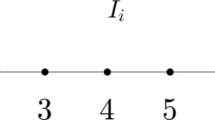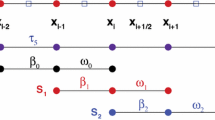Abstract
Based on the recent development of Jacobian-free Lax–Wendroff (LW) approaches for solving hyperbolic conservation laws (Zorio et al. in J Sci Comput 71:246–273, 2017, Carrillo and Parés in J Sci Comput 80:1832–1866, 2019), a novel collection of explicit Jacobian-free multistage multiderivative solvers for hyperbolic conservation laws is presented in this work. In contrast to Taylor time-integration methods, multiderivative Runge–Kutta (MDRK) techniques achieve higher-order of consistency not only through the excessive addition of higher temporal derivatives, but also through the addition of Runge–Kutta-type stages. This adds more flexibility to the time integration in such a way that more stable and more efficient schemes could be identified. The novel method permits the practical application of MDRK schemes. In their original form, they are difficult to utilize as higher-order flux derivatives have to be computed analytically. Here we overcome this by adopting a Jacobian-free approximation of those derivatives. In this paper, we analyze the novel method with respect to order of consistency and stability. We show that the linear CFL number varies significantly with the number of derivatives used. Results are verified numerically on several representative testcases.







Similar content being viewed by others
Availability of Data and Materials
The datasets generated and/or analyzed during the current study are available from the corresponding author on reasonable request mailto: jeremy.chouchoulis@uhasselt.be; jeremy.chouchoulis@uhasselt.be.
References
Abramowitz, M., Stegun, I.A. (eds.): Handbook of Mathematical Functions with Formulas, Graphs and Mathematical Tables. Dover Publications Inc, New York (1964)
Baeza, A., Bürger, R., Martí, M.d.C., Mulet, P., Zorío, D.: On approximate implicit Taylor methods for ordinary differential equations. Comput. Appl. Math. 39(4), 304 (2020)
Carrillo, H., Parés, C.: Compact approximate Taylor methods for systems of conservation laws. J. Sci. Comput. 80(3), 1832–1866 (2019)
Carrillo, H., Parés, C., Zorío, D.: Lax–Wendroff approximate Taylor methods with fast and optimized weighted essentially non-oscillatory reconstructions. J. Sci. Comput. 86, 15 (2021)
Chan, R., Tsai, A.: On explicit two-derivative Runge–Kutta methods. Numer. Algorithms 53, 171–194 (2010)
Christlieb, A.J., Gottlieb, S., Grant, Z.J., Seal, D.C.: Explicit strong stability preserving multistage two-derivative time-stepping schemes. J. Sci. Comput. 68, 914–942 (2016)
Cockburn, B., Karniadakis, G.E., Shu, C.-W.: The development of discontinuous Galerkin methods. In: Cockburn, B., Karniadakis, G.E., Shu, C.-W. (eds.) Discontinuous Galerkin Methods: Theory, Computation and Applications, volume 11 of Lecture Notes in Computational Science and Engineering, pp. 3–50. Springer, Berlin (2000)
Dumbser, M., Balsara, D.S., Toro, E.F., Munz, C.-D.: A unified framework for the construction of one-step finite volume and discontinuous Galerkin schemes on unstructured meshes. J. Comput. Phys. 227(18), 8209–8253 (2008)
Dumbser, M., Enaux, C., Toro, E.F.: Finite volume schemes of very high order of accuracy for stiff hyperbolic balance laws. J. Comput. Phys. 227(8), 3971–4001 (2008)
Dumbser, M., Fambri, F., Tavelli, M., Bader, M., Weinzierl, T.: Efficient implementation of ADER discontinuous Galerkin schemes for a scalable hyperbolic PDE engine. Axioms 7(3), 63 (2018)
Gottlieb, S., Grant, Z.J., Hu, J., Shu, R.: High order unconditionally strong stability preserving multi-derivative implicit and IMEX Runge–Kutta methods with asymptotic preserving properties. arXiv preprint arXiv:2102.11939 (2021)
Gottlieb, S., Shu, C.-W., Tadmor, E.: Strong stability-preserving high-order time discretization methods. SIAM Rev. 43(1), 89–112 (2001)
Guo, W., Qiu, J.-M., Qiu, J.: A new Lax–Wendroff discontinuous Galerkin method with superconvergence. J. Sci. Comput. 65(1), 299–326 (2015)
Hairer, E., Wanner, G.: Solving ordinary differential equations II. Springer Series in Computational Mathematics (1991)
Jaust, A., Schütz, J., Seal, D.C.: Implicit multistage two-derivative discontinuous Galerkin schemes for viscous conservation laws. J. Sci. Comput. 69, 866–891 (2016)
Lax, P., Wendroff, B.: Systems of conservation laws. Commun. Pure Appl. Math. 13(2), 217–237 (1960)
LeVeque, R.J.: Numerical Methods for Conservation Laws. Birkhäuser, Basel (1990)
Li, J., Du, Z.: A two-stage fourth order time-accurate discretization for Lax–Wendroff type flow solvers I. Hyperbolic conservation laws. SIAM J. Sci. Comput. 38(5), A3046–A3069 (2016)
Lu, C., Qiu, J.: Simulations of shallow water equations with finite difference Lax–Wendroff weighted essentially non-oscillatory schemes. J. Sci. Comput. 47(3), 281–302 (2011)
MathWorks. Symbolic Math Toolbox. Natick, Massachusetts, United States (2020). https://www.mathworks.com/help/symbolic/
Ökten Turacı, M., Öziş, T.: Derivation of three-derivative Runge–Kutta methods. Numer. Algorithms 74(1), 247–265 (2017)
Qiu, J.: Development and comparison of numerical fluxes for LWDG methods. Numer. Math. Theory Methods Appl. 1(4), 435–459 (2008)
Qiu, J., Dumbser, M., Shu, C.-W.: The discontinuous Galerkin method with Lax–Wendroff type time discretizations. Comput. Methods Appl. Mech. Eng. 194(42–44), 4528–4543 (2005)
Qiu, J., Shu, C.-W.: Finite difference WENO schemes with Lax–Wendroff-type time discretizations. SIAM J. Sci. Comput. 24(6), 2185–2198 (2003)
Quarteroni, A., Sacco, R., Saleri, F.: Numerical Mathematics. Springer, Berlin (2007)
Ralston, A., Rabinowitz, P.: A First Course in Numerical Analysis. Dover Books on Mathematics. Dover Publications, Mineola (2001)
Schütz, J., Seal, D.C., Jaust, A.: Implicit multiderivative collocation solvers for linear partial differential equations with discontinuous Galerkin spatial discretizations. J. Sci. Comput. 73, 1145–1163 (2017)
Schütz, J., Seal, D.C., Zeifang, J.: Parallel-in-time high-order multiderivative IMEX methods. J. Sci. Comput. 90, 54 (2022)
Schwartzkopff, T., Dumbser, M., Munz, C.-D.: ADER: a high-order approach for linear hyperbolic systems in 2D. J. Sci. Comput. 17, 231–240 (2002)
Seal, D.C., Güçlü, Y., Christlieb, A.: High-order multiderivative time integrators for hyperbolic conservation laws. J. Sci. Comput. 60, 101–140 (2014)
Spiteri, R., Ruuth, S.: A new class of optimal high-order strong-stability-preserving time discretization methods. SIAM J. Numer. Anal. 40(2), 469–491 (2002)
Strikwerda, J.C.: Finite Difference Schemes and Partial Differential Equations, 2nd edn. Society for Industrial and Applied Mathematics, Philadelphia (2004)
Titarev, V.A., Toro, E.F.: ADER: Arbitrary high order Godunov approach. J. Sci. Comput. 17(1), 609–618 (2002)
Titarev, V.A., Toro, E.F.: ADER schemes for three-dimensional non-linear hyperbolic systems. J. Comput. Phys. 204(2), 715–736 (2005)
Whitham, G.: Linear and Nonlinear Waves. Pure and Applied Mathematics: A Wiley Series of Texts, Monographs and Tracts. Wiley, New York (2011)
Zorío, D., Baeza, A., Mulet, P.: An approximate Lax–Wendroff-type procedure for high order accurate schemes for hyperbolic conservation laws. J. Sci. Comput. 71, 246–273 (2017)
Funding
J. Zeifang was funded by the Deutsche Forschungsgemeinschaft (DFG, German Research Foundation) through the Project No. 457811052. The HPC-resources and services used in this work were provided by the VSC (Flemish Supercomputer Center), funded by the Research Foundation-Flanders (FWO) and the Flemish Government.
Author information
Authors and Affiliations
Corresponding author
Ethics declarations
Conflict of interest
The authors declare that they have no known competing financial interests or personal relationships that could have appeared to influence the work reported in this paper.
Code availability
The code can be downloaded from the personal webpage of Jochen Schütz at http://www.uhasselt.be/cmat or directly from http://www.uhasselt.be/Documents/CMAT/Code/MDRKCAT-CMAT.zip.
Additional information
Publisher's Note
Springer Nature remains neutral with regard to jurisdictional claims in published maps and institutional affiliations.
A Butcher Tableaux
A Butcher Tableaux
In this section, we show the multiderivative Runge–Kutta methods used in this work through their Butcher tableaux. We use three two-derivative methods taken from [5], see Tables 3, 4 and 5; two three-derivative methods taken from [21], see Tables 6 and 7; and one four-derivative method, constructed for this paper, see Table 8. This last scheme has been derived from the idea that it should be of form

for  , with update
, with update

These forms have also been used in [5] and [21].
Rights and permissions
About this article
Cite this article
Chouchoulis, J., Schütz, J. & Zeifang, J. Jacobian-Free Explicit Multiderivative Runge–Kutta Methods for Hyperbolic Conservation Laws. J Sci Comput 90, 96 (2022). https://doi.org/10.1007/s10915-021-01753-z
Received:
Accepted:
Published:
DOI: https://doi.org/10.1007/s10915-021-01753-z




